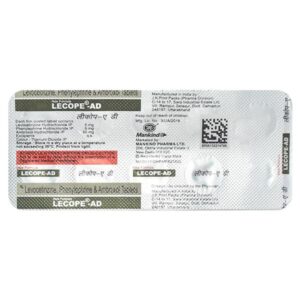AMBROXOL + PHENYLEPHRINE + LEVOCETIRIZINE
Ambroxol: Ambroxol is a medication used primarily to treat respiratory disorders associated with excessive mucus production, such as bronchitis, asthma, and chronic obstructive pulmonary disease (COPD). It works by improving the secretion and clearance of mucus from the respiratory tract, making it easier for patients to breathe.
The exact mechanism of action of Ambroxol is not fully understood, but it is believed to stimulate the production of surfactant, a substance that helps maintain the elasticity of the lungs and prevents them from collapsing. Additionally, Ambroxol increases the activity of cilia, tiny hair-like structures in the respiratory tract that help transport mucus out of the lungs.
Ambroxol is typically taken orally, either as tablets or syrup. The usual adult dose is 30 mg three times a day, while children’s doses are adjusted based on their age and weight. It is important to follow the recommended dosage instructions provided by the healthcare provider or the product label.
While Ambroxol is generally considered safe and well-tolerated, it can cause side effects in some individuals. Common side effects are usually mild and may include nausea, vomiting, gastrointestinal discomfort, and diarrhea. Allergic reactions are rare but can occur and may present as skin rashes, itching, or swelling of the face, lips, or tongue.
Ambroxol should be used with caution in patients with liver or kidney problems. It is generally not recommended during pregnancy unless prescribed by a healthcare professional.
As with any medication, it is important to consult with a healthcare provider before starting Ambroxol to ensure its suitability, especially if you have any pre-existing medical conditions or are taking other medications that may interact with it.
Phenylephrine: Phenylephrine is a medication primarily used as a decongestant to relieve nasal congestion caused by allergic reactions, colds, or sinusitis. It is available in various forms, including nasal spray, oral tablets, and eye drops.
The mechanism of action of phenylephrine involves its stimulation of alpha-adrenergic receptors in the blood vessels, causing them to constrict. This constriction reduces blood flow to the nasal passages and reduces swelling, thereby relieving congestion.
The dose of phenylephrine can vary depending on the form in which it is administered. For nasal congestion, a typical dose of phenylephrine nasal spray is 2-3 sprays into each nostril every 4-6 hours, not exceeding more than 3 doses in a 24-hour period. For oral tablets, the usual adult dose is 10 mg every 4 hours, not exceeding 60 mg in a 24-hour period. For eye drops, 1-2 drops can be instilled in each eye up to 4 times a day.
Potential side effects of phenylephrine may include increased blood pressure, headache, dizziness, nervousness, restlessness, insomnia, and gastrointestinal disturbances such as nausea or stomach upset. These side effects are generally mild and temporary. However, if high doses are taken or if the medication is improperly used, more severe side effects can occur, such as irregular heartbeat, difficulty breathing, chest pain, or severe headache, which may require immediate medical attention.
It is important to note that phenylephrine should be used with caution in individuals with cardiovascular conditions, high blood pressure, diabetes, thyroid problems, or prostate enlargement. In addition, it should not be used in children under the age of 4 without the recommendation of a healthcare professional.
As with any medication, it is essential to follow the recommended dose and consult with a healthcare provider before using phenylephrine, especially if you have any underlying medical conditions or are taking other medications. The information provided here is a general overview, and specific dosing and safety instructions may vary depending on the individual and the product formulation.
Levocetirizine: Levocetirizine is an antihistamine drug that is commonly used to relieve the symptoms of allergic rhinitis (hay fever) and chronic hives (urticaria). It is sold under various brand names, including Xyzal, Levrix, and Xusal.
The mechanism of action of Levocetirizine involves blocking the action of histamine, a chemical substance released by the body during an allergic reaction. By inhibiting the effects of histamine, Levocetirizine helps to alleviate symptoms such as sneezing, runny nose, itching, and watery eyes.
The usual recommended dose of Levocetirizine for adults and children 6 years of age and older is 5 mg once daily. For children aged 2 to 5 years, the recommended dose is 1.25-2.5 mg once daily. Levocetirizine can be taken with or without food, and it is advisable to take it at the same time each day to maintain a consistent level in the body.
Common side effects of Levocetirizine can include drowsiness, fatigue, dry mouth, sore throat, abdominal pain, and headache. While drowsiness is more likely to occur with the first few doses, it usually diminishes with continued use. However, if drowsiness persists or becomes severe, it is advisable to avoid driving or operating heavy machinery.
Serious side effects are rare, but they can include allergic reactions (such as rash, itching, swelling, severe dizziness, and difficulty breathing) that require immediate medical attention. Additionally, individuals with kidney problems may need a lower dose of Levocetirizine, and it is important to consult a healthcare professional for personalized dosing recommendations.
Overall, Levocetirizine is a widely used and effective medication for the relief of allergy symptoms. However, it is always important to follow the dosage instructions provided by your healthcare professional and report any concerning side effects.

